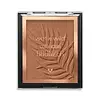What's inside
What's inside
 Key Ingredients
Key Ingredients

 Benefits
Benefits

 Concerns
Concerns

 Ingredients Side-by-side
Ingredients Side-by-side

Mica
Cosmetic ColorantBoron Nitride
AbsorbentSilica
AbrasiveCetearyl Ethylhexanoate
EmollientGlycerin
HumectantMagnesium Stearate
Cosmetic ColorantOctyldodecyl Stearoyl Stearate
EmollientMagnesium Aluminum Silicate
AbsorbentSqualane
EmollientSodium Dehydroacetate
PreservativeCaprylyl Glycol
Emollient1,2-Hexanediol
Skin ConditioningDisodium EDTA
BHT
AntioxidantEthylhexylglycerin
Skin ConditioningTin Oxide
AbrasiveCalcium Sodium Borosilicate
Synthetic Fluorphlogopite
Calcium Aluminum Borosilicate
CI 77891
Cosmetic ColorantIron Oxides
CI 77007
Cosmetic ColorantMica, Boron Nitride, Silica, Cetearyl Ethylhexanoate, Glycerin, Magnesium Stearate, Octyldodecyl Stearoyl Stearate, Magnesium Aluminum Silicate, Squalane, Sodium Dehydroacetate, Caprylyl Glycol, 1,2-Hexanediol, Disodium EDTA, BHT, Ethylhexylglycerin, Tin Oxide, Calcium Sodium Borosilicate, Synthetic Fluorphlogopite, Calcium Aluminum Borosilicate, CI 77891, Iron Oxides, CI 77007
Caprylic/Capric Triglyceride
MaskingSynthetic Fluorphlogopite
Boron Nitride
AbsorbentMicrocrystalline Cellulose
AbsorbentSilica
AbrasiveDimethicone
EmollientMagnesium Myristate
Dimethicone/Vinyl Dimethicone Crosspolymer
Skin ConditioningPhenoxyethanol
PreservativeLauroyl Lysine
Skin ConditioningCaprylyl Glycol
EmollientEthylhexylglycerin
Skin ConditioningHexylene Glycol
EmulsifyingTin Oxide
AbrasiveWater
Skin ConditioningO-Cymen-5-Ol
AntimicrobialTriethoxycaprylylsilane
Iron Oxides
CI 77492
Cosmetic ColorantCI 77499
Cosmetic ColorantMica
Cosmetic ColorantTitanium Dioxide
Cosmetic ColorantCaprylic/Capric Triglyceride, Synthetic Fluorphlogopite, Boron Nitride, Microcrystalline Cellulose, Silica, Dimethicone, Magnesium Myristate, Dimethicone/Vinyl Dimethicone Crosspolymer, Phenoxyethanol, Lauroyl Lysine, Caprylyl Glycol, Ethylhexylglycerin, Hexylene Glycol, Tin Oxide, Water, O-Cymen-5-Ol, Triethoxycaprylylsilane, Iron Oxides, CI 77492, CI 77499, Mica, Titanium Dioxide
Ingredients Explained
These ingredients are found in both products.
Ingredients higher up in an ingredient list are typically present in a larger amount.
Boron Nitride is compound consisting of boron and nitrogen. It is used to absorb oil and modify adherence/ slip in products.
This means it is often used in makeup products to help them last longer.
Caprylyl Glycol is a humectant and emollient, meaning it attracts and preserves moisture.
It is a common ingredient in many products, especially those designed to hydrate skin. The primary benefits are retaining moisture, skin softening, and promoting a healthy skin barrier.
Though Caprylyl Glycol is an alcohol derived from fatty acids, it is not the kind that can dry out skin.
This ingredient is also used as a preservative to extend the life of products. It has slight antimicrobial properties.
Learn more about Caprylyl GlycolEthylhexylglycerin (we can't pronounce this either) is commonly used as a preservative and skin softener. It is derived from glyceryl.
You might see Ethylhexylglycerin often paired with other preservatives such as phenoxyethanol. Ethylhexylglycerin has been found to increase the effectiveness of these other preservatives.
Mica is a naturally occurring mineral used to add shimmer and color in cosmetics. It can also help improve the texture of a product or give it an opaque, white/silver color.
Serecite is the name for very fine but ragged grains of mica.
This ingredient is often coated with metal oxides like titanium dioxide. Trace amounts of heavy metals may be found in mica, but these metals are not harmful in our personal products.
Mica has been used since prehistoric times throughout the world. Ancient Egyptian, Indian, Greek, Roman, Aztec, and Chinese civilizations have used mica.
Learn more about MicaSilica, also known as silicon dioxide, is a naturally occurring mineral. It is used as a fine, spherical, and porous powder in cosmetics.
Though it has exfoliant properties, the function of silica varies depending on the product.
The unique structure of silica enhances the spreadability and adds smoothness, making it a great texture enhancer.
It is also used as an active carrier, emulsifier, and mattifier due to its ability to absorb excess oil.
In some products, tiny microneedles called spicules are made from silica or hydrolyzed sponge. When you rub them in, they lightly polish away dead skin layers and enhance the penetration of active ingredients.
Learn more about SilicaSynthetic Fluorphlogopite is the synthethic version of mica. It consists of fluorine, aluminum and silicate.
Synthetic Fluorphlogopite is used to add volume to products.
It is considered non-irritating on the skin.
Learn more about Synthetic FluorphlogopiteTin Oxide is an inorganic oxide used to add opacity and volume to a product. In nature, it is already found in mineral form. The main ore of tin is an opaque and shiny mineral called casseterite.
Tin Oxide helps remove translucency in a product, or make it more opaque. Besides adding opacity, tin oxide is used for bulking to add volume.
This ingredient is a combination of red, black, and yellow iron oxide pigments. This combination of colors is usually found in foundation, because it results in a "skin" color.